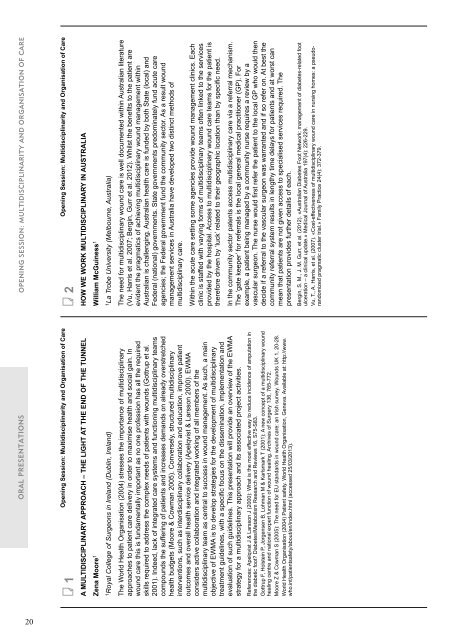Create successful ePaper yourself
Turn your PDF publications into a flip-book with our unique Google optimized e-Paper software.
ORAL PRESENTATIONS<br />
1<br />
Opening Session: Multidisciplinarity and Organisation of Care<br />
A multidisciplinary approach – the light at the end of the tunnel<br />
Zena Moore 1<br />
1 Royal College of Surgeons in Ireland (Dublin, Ireland)<br />
The World Health Organisation (2004) stresses the importance of multidisciplinary<br />
approaches to patient care delivery in order to maximise health and social gain. In<br />
wound care this is fundamentally important as no one profession has all the required<br />
skills required to address the complex needs of patients with wounds (Gottrup et al.<br />
2001). Indeed, lack of integrated care systems and functioning multidisciplinary teams<br />
compounds the suffering of patients and increases demands on already overstretched<br />
health budgets (Moore & Cowman 2005). Conversely, structured multidisciplinary<br />
interventions, such as interdisciplinary collaboration and education, improve patient<br />
outcomes and overall health service delivery (Apelqvist & Larsson 2000). <strong>EWMA</strong><br />
considers active collaboration and integrated working of all members of the<br />
multidisciplinary team as central to success in wound management. As such, a main<br />
objective of <strong>EWMA</strong> is to develop strategies for the development of multidisciplinary<br />
treatment guidelines, with a specific focus on the dissemination, implementation and<br />
evaluation of such guidelines. This presentation will provide an overview of the <strong>EWMA</strong><br />
strategy for a multidisciplinary approach and its associated project activities.<br />
References: Apelqvist J & Larsson J (2000): What is the most effective way to reduce incidence of amputation in<br />
the diabetic foot? Diabetes/Metabolism Research and Reviews 16, S75-S83.<br />
Gottrup F, Holstein P, Jorgensen B, Lohman M & Karlsmark T (2001): A new concept of a multidisciplinary wound<br />
healing centre and national expert function of wound healing. Archives of Surgery 136, 765-772.<br />
Moore Z & Cowman S (2005): The need for EU standards in wound care: an Irish survey. Wounds UK 1, 20-28.<br />
World Health Organisation (2004) Patient safety. World Health Organisation, Geneva. Available at: http://www.<br />
who.int/patientsafety/about/en/index.html (accessed 25/03/<strong>2013</strong>).<br />
OPENING SESSION: MULTIDISCIPLINARITY AND ORGANISATION OF CARE<br />
2<br />
How we work multidisciplinary in Australia<br />
Opening Session: Multidisciplinarity and Organisation of Care<br />
William McGuiness 1<br />
1 La Trobe University (Melbourne, Australia)<br />
The need for multidisciplinary wound care is well documented within Australian literature<br />
(Vu, Harris et al. 2007; Bergin, Gurr et al. 2012). Whilst the benefits to the patient are<br />
evident the pragmatics of achieving multidisciplinary wound management within<br />
Australian is challenging. Australian health care is funded by both State (local) and<br />
Federal (national) governments. State governments predominately fund acute care<br />
agencies; the Federal government fund the community sector. As a result wound<br />
management services in Australia have developed two distinct methods of<br />
multidisciplinary care.<br />
Within the acute care setting some agencies provide wound management clinics. Each<br />
clinic is staffed with varying forms of multidisciplinary teams often linked to the services<br />
provided by the hospital. Access to multidisciplinary wound care teams for the patient is<br />
therefore driven by ‘luck’ related to their geographic location than by specific need.<br />
In the community sector patents access multidisciplinary care via a referral mechanism.<br />
The ‘gate keeper’ for referrals is the local general medical practitioner (GP). For<br />
example, a patient being managed by a community nurse requires a review by a<br />
vascular surgeon. The nurse would first refer the patient to the local GP who would then<br />
decide if a referral to the vascular surgeon was warranted and if so refer on. At best the<br />
community referral system results in lengthy time delays for patients and at worst can<br />
mean that patients are not given access to specialised services required. The<br />
presentation provides further details of each.<br />
Bergin, S. M., J. M. Gurr, et al. (2012). «Australian Diabetes Foot Network: management of diabetes-related foot<br />
ulceration – a clinical update.» Medical Journal of Australia 197(4): 226-229.<br />
Vu, T., A. Harris, et al. (2007). «Cost-effectiveness of multidisciplinary wound care in nursing homes: a pseudorandomized<br />
pragmatic cluster trial.» Family Practice 24(4): 372-379.<br />
20






